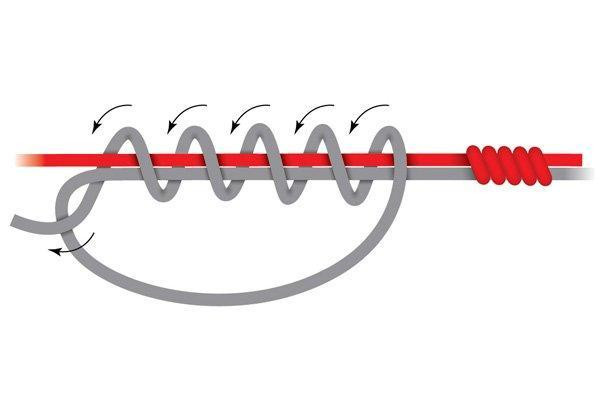The double uni knot, despite its name, isn’t a single knot. It’s actually two trusty uni knots working together to form a secure connection between two fishing lines. This makes it a great choice for joining lines of different diameters, like braided mainline to fluorocarbon leader.
While bulkier than the FG or Alberto knots, the double uni offers impressive strength and effectiveness. Here’s a breakdown of how to tie it:
What you’ll need:
- Braided fishing line
- Fluorocarbon leader
Steps:
-
Overlap and Loop: Overlap the ends of your braid and fluorocarbon leader by a few inches. Create a loop with the braid, big enough to wrap the leader’s tag end around both lines within the loop.
-
First Uni Knot: Now, tie a basic uni knot using the braid. Wrap the braid tag end around the loop 4-5 times (depending on line thickness). Tighten the loop by pulling the braid tag end, then form another loop with the fluorocarbon leader alongside the braid.

-
Second Uni Knot: Wrap the fluorocarbon leader around the braid and itself 4-5 times within the newly formed loop.
-
Tighten and Secure: Pull the fluorocarbon tag end to snug the knot. Now, firmly pull on each main line to slide the two uni knots together. Finally, pull firmly on both tag ends and main lines to cinch the knot down completely.

Tips:
- Line thickness affects the number of wraps needed. Experiment with 3-5 wraps for the braid and leader, aiming for a solid connection between the two uni knots.
- More wraps are generally needed for thinner lines.
- The double uni knot excels when a strong connection is essential, even if it means a slightly larger knot. It works well with both thick and finesse applications.
The double uni knot is versatile, suitable for heavy braid with topwater lures, swimbaits, or even smaller diameter lines used in finesse fishing. By mastering this knot, you’ll have a reliable method for joining various fishing lines in your tackle box!
Images/Source: Wired2Fish





